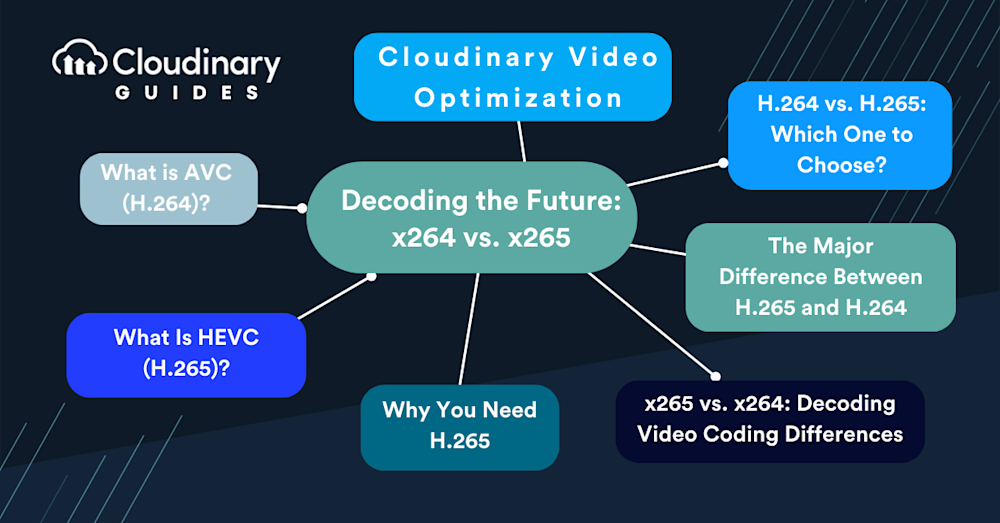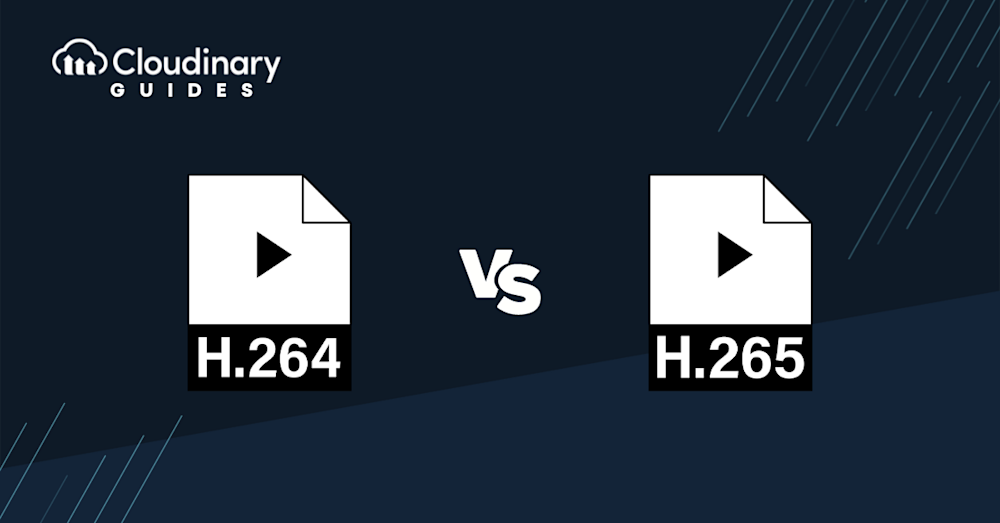The debate of x264 vs. x265 has been a tough one for developers and editors alike. While both have their merits, understanding them well can be the difference between a great user experience and a buffering nightmare.
In this guide we focus on these codecs: their strengths and weaknesses, and learn how Cloudinary is reshaping the landscape of video optimization. Whether you’re a seasoned developer or just dipping your toes into video tech, this guide should provide you with new insights, and a fresh perspective on delivering top-notch video content.
In this article:
- What is AVC?
- What is HEVC?
- x265 History
- Why You Need H.265
- x265 vs. x264: Decoding Video Coding Differences
- The Major Difference Between H.265 and H.264
- H.264 vs. H.265: Which One to Choose?
What is AVC (H.264)?
AVC, also known as H.264. It’s a widely adopted video compression standard. Introduced in 2003, H.264 has been the go-to choice for video streaming, conferencing, and even broadcasting. Its strength? Efficiently compressing video files without compromising too much on quality. If you’ve ever marveled at a crisp video that didn’t devour your bandwidth, there’s a good chance H.264 played a role.
What Is HEVC (H.265)?
HEVC, known as H.265. It’s like the smarter, more efficient younger sibling of H.264. Birthed a decade after H.264, in 2013, H.265 aims to double the data compression ratio while retaining the same level of video quality. Think about streaming a 4K video on your device without constant buffering. That’s the magic of H.265.
x265 History
The development of x265 began in March 2013 by building on the source code from x264, an open-source video encoder for the predecessor MPEG video coding standard, H.264/MPEG-4 AVC. MulticoreWare, the group behind the project, made this new source code publicly accessible on July 23, 2013. The project’s initial funding came from a small collection of charter licensee organizations that influenced its development requirements and gained commercial licenses to use x265 in their products without needing to release their products under the GPL 2 license. In February 2014, x265 was incorporated into the popular multimedia transcoding tool FFmpeg and its offshoot Libav. The first full version (1.0) was finished in May 2014, followed by the stable version (2.0) on July 14, 2016.
Why You Need H.265
You might wonder, “Why should I care about H.265 when H.264 has been serving me just fine?” Here’s the thing: with the proliferation of higher resolutions like 4K and 8K, and the world moving towards more video-centric content, the demand for efficient compression that doesn’t skimp on quality is skyrocketing. H.265 steps in to address this need. It’s designed to use less bandwidth for the same quality or offer higher quality at the same bit rate. If you aim to be ahead of the curve, understanding and leveraging H.265 is crucial.
x265 vs. x264: Decoding Video Coding Differences
X265 and x264 are not sci-fi droids from a galaxy far, far away. They’re both video compression codecs aiming to encode video files into smaller sizes without tossing video quality out the window.
Here are some differences between x265 and x264:
- Release date: X265 was first released in 2013, while x264 was released in 2004. They’re like the classic rock vs. indie debate – both great, but one’s been around a bit longer.
- File size: This is where x265 flexes its muscles. X265 is capable of achieving smaller file sizes or lower bitrates compared to x264 while maintaining acceptable visual quality. If you’re all about efficiency, x265 is a game-changer.
- Compression performance: Both x265 and libvpx outshine x264 when it comes to compression. The magic number? Up to 50% bitrate savings, particularly with higher resolutions. If numbers could talk, these figures would be shouting “efficiency!”
The Major Difference Between H.265 and H.264
Both video compression standards, H.265 and H.264 have distinct differences.
- Efficiency and Quality: H.265 can compress video twice as efficiently as H.264. Imagine having two video files of the same size. The one compressed using H.265 would typically have a noticeable uptick in quality compared to its H.264 counterpart.
- Bandwidth Utilization: With the boom of online streaming platforms and the voracious appetite for high-definition content, bandwidth is precious. H.265 shines here. It uses roughly 50% less bandwidth than H.264 for the same video quality. If you’re looking to stream or share videos without making your users wait, H.265 is your friend.
- Compatibility: Now, this is where H.264 holds an edge. Given its age and widespread adoption, H.264 enjoys broader compatibility across devices and platforms. H.265, being newer, is still paving its way to universal acceptance. So, if you need a video format that’ll play on almost any device without a hitch, H.264 has your back.
- Bandwidth Utilization: With the boom of online streaming platforms and the voracious appetite for high-definition content, bandwidth is precious. H.265 shines here. It uses roughly 50% less bandwidth than H.264 for the same video quality. If you’re looking to stream or share videos without making your users wait, H.265 is your friend.
- Licensing: From a developer’s standpoint, licensing is a critical factor. H.264’s licensing terms, managed by MPEG LA, are well-known and straightforward. H.265, however, has a more complex licensing landscape, which might require some navigation.
H.264 vs. H.265: Which One to Choose?
With all that said, which codec should you bet on? The answer, classic as it might sound, depends on your needs.
If you’re gunning for top-tier video quality and efficient compression, especially for 4K and above resolutions, H.265 is the clear winner. Sure, it might take a bit more time to encode and might give you a hiccup or two on older devices, but the quality and efficiency trade-off is hard to ignore.
On the flip side, if compatibility, speed, and a straightforward licensing model are higher on your priority list, H.264 won’t let you down. It’s reliable, widely accepted, and a solid choice for general video encoding tasks.
But wait, there’s a twist in our tale: What if there’s a platform that can help you optimize your videos, regardless of the codec you choose?
Cloudinary Video Optimization
If you want to deliver high-quality videos without getting bogged down in the details of codecs, Cloudinary is your solution.
Cloudinary’s video solution optimizes and delivers videos based on the viewer’s device, browser, and bandwidth conditions. Whether your video is H.264 or H.265, Cloudinary delivers it in the best possible format, size, and quality, tailored to each viewer.
Imagine not having to fret about file sizes, formats, or compatibility issues. With Cloudinary, you can focus on creating captivating content, leaving the optimization magic in capable hands.
So, in the grand debate of x264 vs. x265, remember: while each has its strengths and trade-offs, platforms like Cloudinary offer an overarching solution that takes the guesswork out of video optimization.



